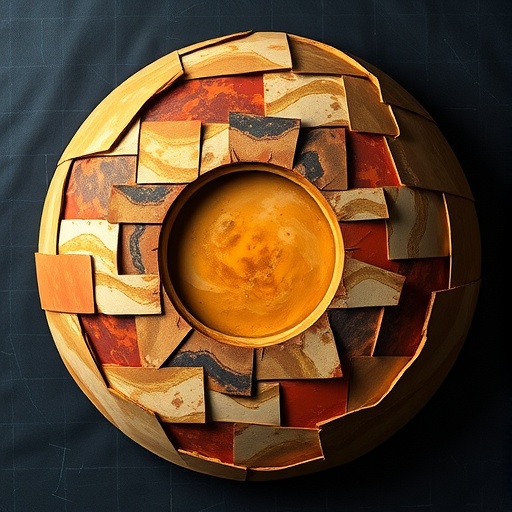Our solar system, a vast collection of celestial bodies, has presented a series of mysteries and captivating phenomena since its inception. A groundbreaking study from Yale University sheds new light on these origins, suggesting that the formation of Earth and other planets was marked by intense collisions and transformations rather than a tranquil accumulation of elements. This revolutionary perspective presents the early solar system as a dynamic and tumultuous environment, akin to a bin of colorful LEGO blocks, undergoing constant reconfiguration.
Damanveer Singh Grewal, an assistant professor of Earth and planetary science at Yale, leads the charge in revealing the chaotic beginnings of our solar system. In a published paper in the journal Science Advances, he and his colleagues detail how this violent history of growth contrasts sharply with the previously held belief that the planets formed from pristine sources of materials. They propose that recycled fragments from breaks and reassemblies of early planetesimals heavily influenced the final makeup of planetary bodies, including Earth.
Instead of forming in isolation with unique and uncontaminated materials, planets likely shared a common narrative filled with collisions. Previous studies have established that both planets and protoplanets—referred to as planetesimals—became significant through a blend of violent impacts and the gradual formation of their cores. However, this new research underscores the intensity and prevalence of these collisions, manifesting in the resulting diversity and complexity seen across planets today.
The inquiry began with a reinterpretation of data obtained from iron meteorites, which are remnants of the metallic cores from the earliest planetesimals. By examining these materials, the researchers constructed simulations illustrating how early planetary cores were formed. Their findings indicate that high-energy collisions ignited approximately 1 to 2 million years following the initial formation of the solar system. During this period, some planetesimals had already developed metal-rich cores, but the amalgamation process was far from complete.
As these cores underwent collisions, they were shattered, forming fragments that later combined to birth new planetary bodies. This cycle of destruction and reconstruction effectively shaped the elemental make-up of these young worlds, which in turn influenced the developmental pathways trending towards their formation. Moreover, the dynamic nature of this chaotic environment resulted in a higher variability of materials fuelling planet formation than previously recognized.
The investigators posited that these violent impacts transformed the core development into a multifaceted process, breaking apart the traditional notion that core formation was strictly a gradual and peaceful endeavor. Rather, the evidence suggests that the solar system’s early cosmic landscape was rife with energetic disruptions and reconfigurations. Each collision contributed uniquely to the blend of chemicals and isotopes found in space today.
Such findings compel scientists to reconsider the framework of planetary formation and how elemental distributions fundamentally dictate the properties of planets. The implications stir curiosity regarding the varying terrains and atmospheres existing within our solar system. Moreover, understanding how cores emerged from the fallout of chaotic collisions can assist scientists in studying other cosmic bodies, not only in our solar system but beyond.
One of the study’s co-authors, Varun Manilal, highlighted the significant implications of these findings for our understanding of planetary formation. As a graduate student in Earth and planetary sciences, he echoed Grewal’s sentiments regarding how new insights into collision dynamics reveal a richly woven history critical to our cosmic narrative. This collaborative study, with contributions from a diverse team of esteemed scientists, stands as a pivotal moment in astronomical research that has the potential to inspire further exploration.
As the research unfolds, it becomes evident that our solar system’s origins were anything but conventional. The study’s revelations embody a quantum leap in understanding celestial mechanics and the intricate processes that shape planetary bodies.
This exploration into our solar system’s formation raises profound questions regarding the very nature of cosmic evolution and how foundational events lead to the diverse entities present in the universe today. The concept of recycling elements through shattering and remaking, reminiscent of abstract art built from fragments, signifies not just the formation of planets but also encourages a new perspective about the life cycle of materials in space.
By enhancing our comprehension of early planetary development, researchers are paving the way for future studies that will delve deeper into the history of our solar system. Each revelation serves as a stepping stone towards unlocking the mysteries of how our planetary home came to be, emphasizing the importance of ongoing research and collaboration in the scientific community.
Ultimately, this study offers a rich tapestry of interactions that characterize the evolution of our solar system. As additional data and insights emerge, the redefined understanding of our planetary origins presents exciting opportunities for education, exploration, and discovery. The narrative continues to unfold, revealing a cosmos that is as intricate and vibrant as human imagination permits.
Subject of Research: The chaotic origins of planetary cores in the early solar system
Article Title: Protracted Core Formation and Impact Disruptions Shaped the Earliest Outer Solar System Planetesimals
News Publication Date: 1-Oct-2025
Web References: DOI Link
References: Journal Science Advances
Image Credits: Yale University
Keywords
Solar System, Planet Formation, Planetary Science, Cosmology, Planetary Cores, Planetary Evolution, High-energy Collisions, Nebular Gas, Planetary Materials, Earth Sciences, Cosmic History, Astrophysics.




